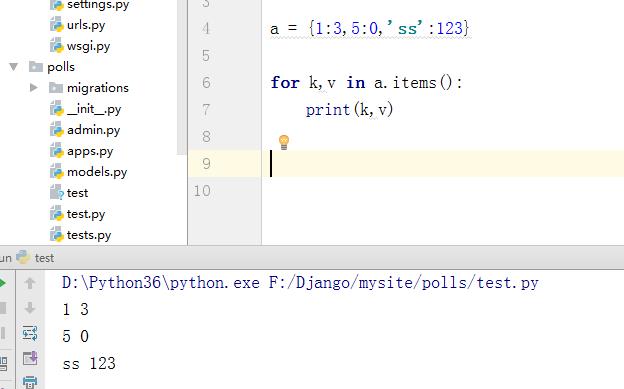python数据结构之字典
Posted 山外云
tags:
篇首语:本文由小常识网(cha138.com)小编为大家整理,主要介绍了python数据结构之字典相关的知识,希望对你有一定的参考价值。
1、python字典的定义
1、用大括号{},以逗号分隔每个键值对,键与值之间用冒号连接
2、键:需要不可变的数据结构,值可以是任意的数据对象
3、字典是无序的,键在字典中必须是唯一,在字典中取值的方式是以键寻找相对应的的值
a = {} c = dict() a {} c {} b = {\'a\':\'hello\',\'c\':\'you\',\'b\':\'how\'} a = [1,2,3] b = [\'a\',\'b\',\'c\'] d = dict(zip(a,b)) d {1: \'a\', 2: \'b\', 3: \'c\'} 给字典中的项value赋值 a = {1:23} a[1] = 3 a {1: 3} 字典的访问 b {\'a\': \'hello\', \'c\': \'you\', \'b\': \'how\'} b.get(\'a\') \'hello\'
增: fruits {\'a\': \'apple\', \'b\': \'banana\', \'g\': \'grape\', \'o\': \'orange\'} fruits.setdefault(\'martin\',20) 20 fruits.setdefault(\'a\',\'appleaaa\') \'apple\' fruits {\'a\': \'apple\', \'b\': \'banana\', \'g\': \'grape\', \'o\': \'orange\', \'martin\': 20} fruits.update({3:5}) fruits.update({\'a\':\'appleupdate\'}) fruits {\'a\': \'appleupdate\', \'b\': \'banana\', \'g\': \'grape\', \'o\': \'orange\', \'martin\': 20, 3: 5} 2) setdefault:参数是key和value,如果key不存在,在添加key:value,如果key存在,什么也不做。 3) update:参数是key和value,不管key存不存在,都变成 key:value的形式。 删除(工作中不常用) fruits {\'a\': \'appleupdate\', \'b\': \'banana\', \'g\': \'grape\', \'o\': \'orange\', \'martin\': 20, 3: 5} fruits.pop(3) 5 fruits {\'a\': \'appleupdate\', \'b\': \'banana\', \'g\': \'grape\', \'o\': \'orange\', \'martin\': 20} 改: 1、赋值 2、update a {2: 9, 3: 5, 4: 9} a[0] = 8 a {2: 9, 3: 5, 4: 9, 0: 8} a[2] = 8 a {2: 8, 3: 5, 4: 9, 0: 8} a.update({3:10}) a {2: 8, 3: 10, 4: 9, 0: 8} 查 a {2: 8, 3: 10, 4: 9, 0: 8} a.get(2) 8 a[0] 8 两种取值的区别: 当key不存在的时候,get不会报错, 通过[key]方式去取值的时候,会报错
字典的遍历 1、for item in _dict: print itme 2、for k,v in a.items(): print k,v a = {1:3,5:0,\'ss\':123} for item in a: print(item) a = {1:3,5:0,\'ss\':123} for k,v in a.items(): print(k,v)
当把字典当成序列的时候,指的是key组成的序列

超市购物
#coding:gbk import sys food_price = {\'apple\':5, \'orange\': 8, \'banana\':3, \'beef\':40, \'pork\':26, \'cocacola\':3} while True: try: money = int(input(\'pls input your money: \')) break except: print(\'your input in not conrrect,pls input a number\') shooping_list = [] while True: print(\'\\n 目前可购买的商品:\') for food,price in food_price.items(): print(food,price) if money < min(food_price.values()): print(\'\\n sorry,you have not enough money to buy any food\\n\') if shooping_list: print(\'\\n 你已经买了如下商品:\\n %s\' %shooping_list) print(\'\\n 你现在有%s,选择一支商品吧\' % money) _choice = input(\'\\n pls input your choice:\') choice = _choice.strip() if choice in [\'quit\',\'exit\',\'q\']: print(\'\\n 你已经买了如下商品 \\n %s\' %shooping_list) sys.exit() if choice not in food_price: print(\'\\n 你已经买了如下商品\\n %s\' %shooping_list) continue price = food_price[choice] print(\'\\n 你选择的商品:%s的价格:%s\' %(choice,price)) if money >= price: shooping_list.append(choice) money = money - price print(\'\\n你的余额是 %s \\n\' % money) else: print(\'\\nsorry,买不起,您剩余:%s$, %s 的价格是 %s $, 真穷!\' % (money, choice, price))
以上是关于python数据结构之字典的主要内容,如果未能解决你的问题,请参考以下文章